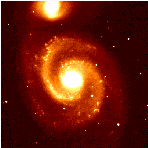DARK
MATTER
We believe that most of the matter in the universe is dark, i.e.
cannot be detected from the light which it emits (or fails to emit).
This is "stuff" which cannot be seen directly -- so what makes us think that
it exists at all?
Its presence is inferred indirectly from the
motions of astronomical objects,
specifically stellar, galactic, and galaxy cluster/supercluster observations.
It is also required in order to enable
gravity to amplify the small
fluctuations in the Cosmic Microwave
Background enough to form the large-scale
structures that we see in the universe today.
 |
 |
| Dark matter |
Not dark matter |
For each of the stellar, galactic, and galaxy cluster/supercluster
observations the basic principle is that if we measure velocities in some
region, then there has to be enough mass there for gravity to stop all the
objects flying apart.
When such velocity measurements are done on large scales, it turns out that
the amount of inferred mass is much more than can be explained by the luminous
stuff. Hence we infer that there is dark matter in the Universe.
Dark matter has important consequences for the evolution of the Universe and
the structure within it.
According to general relativity, the Universe must conform to one of three
possible types: open, flat, or closed.
The total amount of mass and energy in the universe determines which of the
three possibilities applies to the Universe.
In the case of an open Universe, the total mass and energy density (denoted
by the greek letter Omega) is less than unity.
If the Universe is closed, Omega is greater than unity.
For the case where Omega is exactly equal to one the Universe is
"flat".
Note that the dynamics of the Universe are not determined entirely
by the geometry (open, closed or flat) unless the Universe contains only
matter. In our Universe, where most of Omega comes from dark energy,
this relation between the mass density, spatial curvature and the future
of the universe no longer holds.
It is then no longer true in this case that "geometry (spatial curvature)
is destiny." Instead, to find out what will happen one needs to
calculate the evolution of the expansion factor of the
universe for the specific case of matter density, spatial curvature and
"funny energy" to find out what will happen.
Dark matter (DM) candidates are usually split into two broad
categories, with the second category being further sub-divided:
- Baryonic
- Non-Baryonic
- hot dark matter (HDM) and
- cold dark matter (CDM),
depending on their respective masses and speeds.
CDM candidates travel at slow speeds (hence "cold") or have little pressure,
while HDM candidates move rapidly (hence "hot").
For more information
Aside on flatness
Current indications from the cosmic microwave background are that the
universe is spatially flat. That implies that the sum of all of the
energy (density) in the universe equals the critical density, i.e. the
total Omega is 1. This is quite interesting because as the
Universe expands the value of Omega changes.
In fact the value 1 is unstable, and the Universe would prefer to evolve
towards one of the two natural values: 0, if the expands forever further
apart until the Universe is almost totally empty ; and infinity,
if the matter recollapses to a state of higher and higher density.
Then the observation that Omega is fairly close to 1 today, means
that it must have been even closer to 1 in the past.
It is unsatisfying to believe that we just happen to live at the time when
Omega is just starting to depart from 1 by a small factor. It is
much more appealing to consider that we do not live at a special epoch, so
that Omega is still close to 1 today. But then we need to explain
why Omega started out very close to 1 in the early universe.
The theory of inflation provides just such a justification - most versions of
inflation predict that the early Universe was driven extremely close to flat,
and that it is still very close to flat today. If this is so, then at least
90% the energy of the Universe is dark!
Note that although the universe may be flat, that does not mean that
matter makes up the critical density. In addition to dark matter
there is dark energy, e.g. a cosmological constant, that needs to be
included in the accounting.
 Back to Home Page
Back to Home Page
Back to
Site Index



